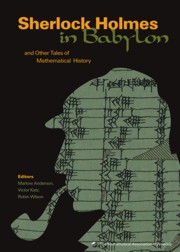Book contents
- Frontmatter
- Introduction
- Contents
- Ancient Mathematics
- Medieval and Renaissance Mathematics
- The Seventeenth Century
- The Eighteenth Century
- Foreword
- Brook Taylor and the Mathematical Theory of Linear Perspective
- Was Newton's Calculus a Dead End? The Continental Influence of Maclaurin's Treatise of Fluxions
- Discussion of Fluxions: from Berkeley to Woodhouse
- The Bernoullis and the Harmonic Series
- Leonhard Euler 1707–1783
- The Number e
- Euler's Vision of a General Partial Differential Calculus for a Generalized Kind of Function
- Euler and the Fundamental Theorem of Algebra
- Euler and Differentials
- Euler and Quadratic Reciprocity
- Afterword
- Index
- About the Editors
Leonhard Euler 1707–1783
from The Eighteenth Century
- Frontmatter
- Introduction
- Contents
- Ancient Mathematics
- Medieval and Renaissance Mathematics
- The Seventeenth Century
- The Eighteenth Century
- Foreword
- Brook Taylor and the Mathematical Theory of Linear Perspective
- Was Newton's Calculus a Dead End? The Continental Influence of Maclaurin's Treatise of Fluxions
- Discussion of Fluxions: from Berkeley to Woodhouse
- The Bernoullis and the Harmonic Series
- Leonhard Euler 1707–1783
- The Number e
- Euler's Vision of a General Partial Differential Calculus for a Generalized Kind of Function
- Euler and the Fundamental Theorem of Algebra
- Euler and Differentials
- Euler and Quadratic Reciprocity
- Afterword
- Index
- About the Editors
Summary
Born in 1707, Leonhard Euler grew up in the town of Riehen, near Basel, Switzerland. Encouraged by his father, Paulus, a minister, young Leonhard received very early instruction from Johann I Bernoulli, who immediately recognized Euler's talents. Euler completed his work at the University of Basel at age 15, and at age 19 won a prize in the competition organized by the Academy of Sciences in Paris. His paper discussed the optimal arrangement of masts on sailing ships (Meditationes super problemate nautico…). In 1727 Euler attempted unsuccessfully to obtain a professorship of physics in Basel by submitting a dissertation on sound (Dissertatio physica de sono); however, this failure, in retrospect, was fortunate. Encouraged by Nicholas and Daniel, sons of his teacher Johann Bernoulli, he went to the St. Petersburg Academy in Russia, a field of action that could accommodate his genius and energy.
In St. Petersburg Euler was met by compatriots Jacob Hermann and Daniel Bernoulli and so befriended the diplomat and amateur mathematician Christian Goldbach. During the years 1727–1741 spent there, Euler wrote over 100 scientific papers and his fundamental work on mechanics. In 1741, at the invitation of Fredrick the Great, he went to the Akademie in Berlin. During his 25 years in Berlin, his incredible mathematical productivity continued. He created among other works, the calculus of variations, wrote the Introductio in analysin infinitorum (see Fig. 1), and translated and rewrote the treatise on artillery by Benjamin Robins.
- Type
- Chapter
- Information
- Sherlock Holmes in BabylonAnd Other Tales of Mathematical History, pp. 336 - 345Publisher: Mathematical Association of AmericaPrint publication year: 2003

